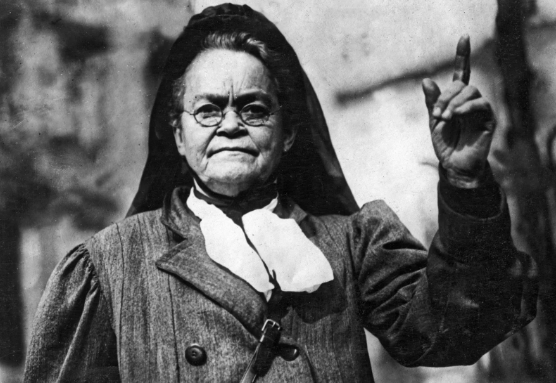
Carry A. Nation was most of her life named just Carrie Nation. She changed her name in 1903 as a publicity stunt and because she thought it would make the point that God wanted to her to carry the American nation into a world free of alcohol.
She was born in 1846 into what would today be called a dysfunctional family. Her mother was delusional and thought she was the Queen of England, spending her last years in an insane asylum. Carry wrote a strange and not always credible autobiography titled The Use and Need of the Life of Carry A Nation. She wrote that as a child, sometimes she escaped from her parents by sleeping in the cabin of the slave couple her family owned.
As was common in rural America in those days, her family moved often, from Kentucky toMissouri, then to Texas, and then back to Missouri. Her family ran a boardinghouse, which might be described as an early version of board and breakfast. Boarders might stay for a long time, and all the
boarders would eat together, sometimes with the family. One of the boarders in the place was a Dr. Charles Gloyd, and Carry fell for him. They married in 1867, against her parent’s wished. He was apparently a kind man who was also an alcoholic and his alcoholism killed him two years later. Carry was left with a child and mother-in-law to support.
Carry was somehow admitted to a Normal Institute, which then meant a teacher training school, roughly equivalent to a community college today. She got enough education to qualify as a teacher, and supported her family from her meager earnings as a teacher. Her only daughter also had some kind of mental illness and was in and out of mental asylums her whole life, but she did marry had had five children.
Carry married again in 1874 to a man named David Nation who was 19 years her senior. Nation
was one of those amiable men who was a failure at everything he did, including preaching. Carryattended his church and sometimes would stand up and verbally correct what she thought was wrong with his sermons. They managed to stay married until 1902, when she filed for divorce and he faded from her life.
They moved to Texas where they went broke trying to raise cotton. Carry was hired to manage a hotel, which she did well. Her husband got into some kind of trouble in Texas, so they moved to Medicine Lodge, Kansas, where she again managed a hotel. She became notorious for openly criticizing the mayor and others in her town for not enforcing the Kansas laws that made the manufacture and sale of alcohol illegal.
Carry was appointed as evangelist to the Barber County jail. She claimed that every man she talked to was in jail because of crimes and abuse committed while under the influence of alcohol. She spoke out, but on June 6, 1900 she went to the nearby town of Kiowa, Kansas. She walked into a saloon carrying a Bible, bricks and a hatchet, and proceeded to smash everything in sight by throwing bricks. She grabbed cues and billiard balls from the pool tables and threw them at the whisky bottles behind the bar. Then she walked across the street and trashed two more saloons. She was a large strong woman and did a great deal of damage. No charges were filed because technically, selling alcohol was
illegal in Kansas.
In December of 1900 she struck again. At 8:00 in the morning, she attacked the most upscale bar inWichita, the largest city in Kansas. She had an iron bar and smashed the big mirror behind the bar and attacked a large nude painting of Cleopatra. Then she attacked another bar across the street, using her hatchet to break bottles of booze. This time she was arrested and spent three weeks in jail.
He attacks on bars and saloons made her nationally famous. She continued her attacks for
several years. This was dangerous. She was arrested 30 times and was attacked more than once. In one attack an enraged bartender broke a chair over her head, and in another she was beaten by a group of prostitutes. She came close to being lynched.
The remaining years of her life she spent as a traveling lecturer on Prohibition, the cause that wanted a total ban on alcohol in the United States. She went on nationwide tours, blasting alcohol and bars, but also going after smoking. She sometimes confronted smokers at her speeches, knocking cigars out of men’s mouths. She also sold miniature replicas of her famous bar-smacking hatchet and gear such as glasses with her image on it. She made $300 a week speaking, good money in her era. She twice tried to publish Prohibitionist newspapers, one called The Hatchet and another The Smasher, both referring to her raids on Kansas saloons.
She spoke on the Chautauqua circuit, which was
an organized sequence of talks and lectures in hundreds of communities, usually weekly. She alsoappeared on the vaudeville circuit, which meant appearing alongside comedians, clowns in blackface, and burlesque dancers. She thought she could better reach sinners that way.
In 1902 she made about$5,000 in speaking fees, extremely good money then. She had enough money to buy property, and during her last two years, she set up what she ironically named “Hatchet Hall” in two houses she bought. She made it a refuge for women who were abused by alcoholic and violent husbands.
In 1911, she was giving a Prohibitionist speech and collapsed on stage. She died shortly after. She did not live to see Prohibition win and make the manufacture, sale, possession or use of alcohol illegal in the US.
Deep knowledge, every day.
Like, comment and follow : Greg’s Business History.
Happy Reading.
Thanks

Leave a comment